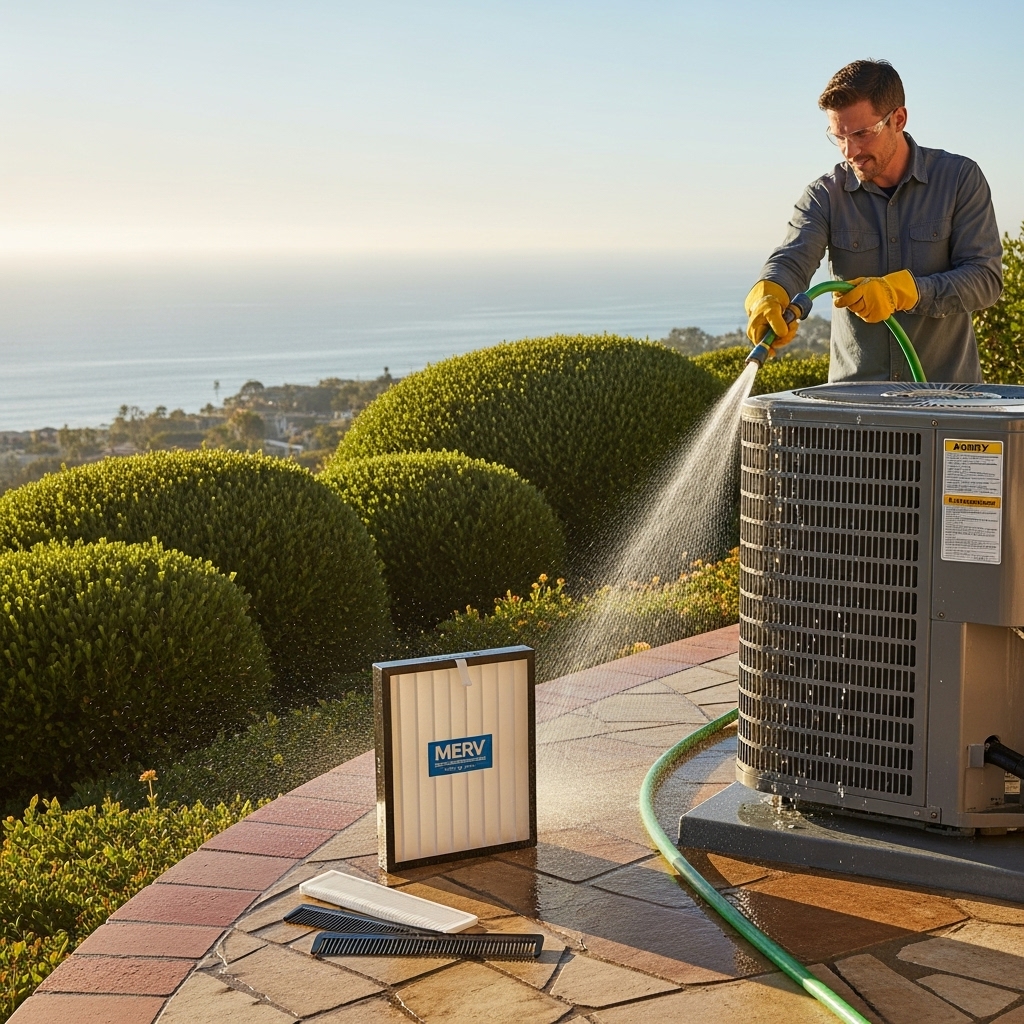Living by the Pacific brings a unique combination of sun, salt air, fog, and seasonal winds that can be unusually tough on residential cooling equipment. If you own a home in Malibu, a thorough, locally informed maintenance routine can keep your system dependable through marine layers in the morning and warm afternoons that pop up without warning. This guide delivers a step-by-step checklist you can follow all year long to protect performance, indoor comfort, and energy efficiency. In the first few steps, you will see how to align basic homeowner tasks with the kind of professional tune-ups that extend equipment life. If you are new to ownership or simply want a refresher, start here and bookmark it. Throughout, you will see why caring for your air conditioning system matters even on days the ocean breeze feels cool.
Because Malibu’s microclimates shift dramatically between the beach, canyons, and hills, no two homes experience heat and humidity the same way. Salt spray can corrode fins and small electrical connections, wildfire seasons add fine particulates to coils and filters, and coastal fog can leave carports and pads damp for hours each morning. The maintenance strategy below takes all of that into account, showing you when to check, what to clean, and which warning signs call for professional attention.
Use this checklist to complement, not replace, expert service. By pairing basic upkeep with an annual tune-up, you prevent little issues from becoming mid-summer breakdowns. You will also keep warranties intact and help your system meet its rated efficiency in real-world Malibu conditions.
Why Malibu homes need a specialized checklist
Malibu’s salt-laden air accelerates exterior corrosion, which can reduce heat transfer at the outdoor coil and stress the compressor. Morning fog and cool nights followed by warm afternoons make for frequent cycling that magnifies any airflow restriction. Santa Ana winds can load filters with dust and pollen in a single day. Each of these realities makes routine inspection and cleaning nonnegotiable if you want steady comfort.
Beyond climate, Malibu’s varied architecture—from hillside modern builds to older bungalows—creates different duct lengths, attic temperatures, and exposure to the sun. Homes with flat roofs or rooftop condensers are also more vulnerable to UV damage on line-set insulation. All of these factors shape a smart maintenance plan.
Safety first
Before you touch anything, cut power to the system at the thermostat and the outdoor unit’s disconnect. If you are unsure how to do that, stop and call a licensed technician. Never reach into a running fan, never remove service panels without training, and never work around capacitors or refrigerant lines. Cleaners should be non-corrosive and safe for coils. Wear gloves and eye protection when rinsing coils or handling biological growth near the condensate drain.
Tools and supplies
- Replacement air filters that match your system size and MERV rating
- Garden hose with gentle spray nozzle
- Fin comb or soft-bristle coil brush
- Level or shims to correct an uneven outdoor pad
- Microfiber cloths and a vacuum with a brush attachment
- Distilled white vinegar for the condensate drain
- Flashlight, screwdriver for grille covers, and a small mirror for hard-to-see spaces
Monthly quick checks
- Inspect and replace filters as needed. In Malibu’s dusty, salty conditions, even “90-day” filters often need monthly inspection. Households with pets or residents with allergies should check twice per month during peak season.
- Look for debris around the outdoor unit. Clear leaves, grasses, and blown trash at least two feet in every direction. Trim shrubs that encroach into the air path.
- Listen for changes. Any new rattle, vibration, or metallic ping can signal a loose panel, fatigued fan blade, or mounting issue.
- Scan the thermostat. Verify the schedule and temperature setpoints match your comfort goals. Make sure batteries are fresh if your model uses them.
- Check supply and return grilles. Open all supply grilles at least halfway and confirm returns are not blocked by furniture or rugs.
Seasonal deep maintenance
Organize your year with the ocean-influenced rhythm of Malibu weather so you never miss an important task.
- Early spring start-up: Before the first real warm spell, gently rinse the outdoor coil from the inside out if accessible, or from the outside with a low-pressure spray. Straighten minor fin bends with a fin comb. Verify the outdoor pad is level and stable. Inspect the line-set insulation for UV cracks. Pour one cup of vinegar into the indoor condensate drain access (if provided) to discourage algae growth. Replace or upgrade filters to the preferred MERV rating for your home.
- Mid-summer check: Heat waves and rolling fog can stress your system in different ways. Clean the outdoor coil again if you smell a sea-salt tang or see visible film. Confirm proper clearance for airflow. Wipe down indoor returns and supply grilles. If the air feels clammy, review fan settings and run times.
- Early fall cleanup: After Santa Ana winds or a smoky period, replace the filter even if it looks “okay.” Residual ash and dust reduce airflow and can cake onto the indoor coil. Inspect attic ducts for dislodged insulation, especially if wildlife have been active.
- Winter prep: Malibu winters are mild but damp, which invites corrosion. Rinse the outdoor unit one more time on a warmer, dry day. Verify the disconnect is weather-tight, and check that the condensate drain is dry and clear so it will be ready next spring.
Indoor airflow and air quality
Good airflow protects components and improves comfort. Keep door undercuts or transfer grilles clear so returns can pull air back to the air handler. Vacuum supply registers and returns with a brush attachment to remove dust that can impede flow. If you have high ceilings or an open stair, consider running ceiling fans on low to mix air without creating drafts.
Filters are your first defense against Malibu’s coastal particulates. Balance protection and airflow: very high-MERV filters catch more particles but restrict flow in some systems. If you notice whistling at the return, increased noise, or reduced cooling, ask a professional to test static pressure and recommend the best filter rating for your equipment and duct design.
Outdoor unit care in a coastal environment
Salt air is relentless. Rinse—not pressure wash—the outdoor coil several times per year. Direct the stream parallel to the fins to avoid folding them over. Never use harsh chemicals unless specified by your manufacturer. Verify that the cabinet screws are snug and the service panel fits tightly to keep moisture from wicking in. If your unit is within a few blocks of the beach, talk to your contractor about coastal-rated coatings and stainless hardware during your next professional service.
Keep at least 24 inches of open space around the unit and five feet above. Don’t store surfboards, bikes, or bins nearby where they can block exhaust air or blow into the fan during a wind event. If erosion or settling has tilted the pad, carefully re-level it so oil returns properly inside the compressor.
Thermostat and control strategy
Smart thermostats can reduce unnecessary runtime by adapting to Malibu’s quick temperature swings. Program modest setbacks during times you’re typically away, but avoid extreme setbacks that force long recovery runs on humid days. In foggy conditions, constant fan “on” can re-evaporate moisture from the indoor coil and make the house feel clammy; the “auto” setting is usually best for comfort.
Ducts, insulation, and attic conditions
Attics over the coast can trap moisture at night and heat up rapidly by afternoon. Inspect duct insulation for tears and compressed sections. Look for loose or missing mastic at joints and boot connections. Seal gaps around ceiling penetrations to reduce hot attic air infiltration. Even minor leaks can drive up runtime and compromise rooms farthest from the air handler.
Energy-saving habits that matter here
- Close shades on west-facing glass in the afternoon to slash heat gain.
- Use bathroom and kitchen exhaust fans to pull out humidity from showers and cooking.
- Pre-cool living spaces slightly before late-day gatherings, then let the system maintain rather than chase the temperature.
- Schedule heat-generating chores—laundry, dishwashing—for cooler times.
In the middle of your maintenance season, it can help to revisit fundamental best practices and refresh your understanding of how air conditioning equipment responds to Malibu’s salt air, fog, and winds. A short reset of habits—like replacing a filter sooner or rinsing the outdoor coil after a marine layer—can prevent the most common comfort complaints.
When to call a professional
Stop DIY efforts and call for expert service if you observe icing on refrigerant lines, repeated breaker trips, a sweet chemical odor, oil stains near line connections, or the outdoor fan failing to start while the compressor hums. These symptoms point to issues that require specialized tools and training, such as refrigerant diagnostics, capacitor testing, motor replacement, or control board faults.
An annual tune-up should include coil cleaning, electrical testing, refrigerant performance checks, airflow measurement, and thermostat calibration. In coastal zones, ask about protective coatings, anti-corrosion treatments, and a schedule tailored to your proximity to the water.
Troubleshooting quick checks
- No cooling: Verify the thermostat is set to “cool,” temperature set lower than room, and batteries (if present) are fresh. Check the breaker and outdoor disconnect. Replace a dirty filter and wait for any ice to melt before restarting.
- Uneven rooms: Open all supply registers, remove blockers, and run the system for one full cycle. If a far room still lags, you may have duct design or balancing issues that need professional attention.
- Water near the air handler: Clear the condensate line with vinegar if you have an accessible cleanout. If water persists or the float switch trips repeatedly, call for service.
- Strange odors: Musty smells often point to a dirty drain pan or standing water. Burning or electrical smells warrant immediate shutdown and professional inspection.
Frequently asked questions
Q: How often should Malibu homeowners replace filters? A: Check monthly and expect more frequent changes during wildfire smoke events, Santa Ana winds, or after hosting guests. Pet households often need replacements every 30 to 45 days in cooling season.
Q: Is rinsing the outdoor unit safe? A: Yes, with gentle, low-pressure water. Always cut power first. Avoid pressure washers, which can damage fins and drive water where it does not belong.
Q: What MERV rating is best near the coast? A: It depends on your system’s airflow capacity. Many homes do well with mid-range MERV that balances filtration and static pressure. Have a pro measure static pressure to guide the choice.
Q: Do I need professional coil cleaning every year? A: In Malibu, many homes benefit from annual coil service because salt residue and airborne particulates accumulate faster than in inland areas.
Q: How can I reduce the clammy feeling on foggy days? A: Use “auto” fan mode, avoid oversizing, and consider dehumidification strategies recommended by a contractor. Keep doors and windows closed when the system runs.
Q: Will coastal coatings really help? A: Protective coatings and stainless fasteners can slow corrosion significantly for homes close to the water or on bluff-top locations where salt spray is frequent.
Q: What’s the simplest task with the biggest payoff? A: Filter diligence. Keep returns clear and filters fresh, and many other problems never start.
Ready for a smoother season?
If you want confidence heading into Malibu’s warm afternoons, schedule a professional tune-up and use this checklist to keep the system humming in between. For insights on selecting, caring for, and optimizing modern air conditioning equipment, connect with a trusted local specialist who understands coastal conditions and can tailor recommendations to your home’s location and lifestyle.

